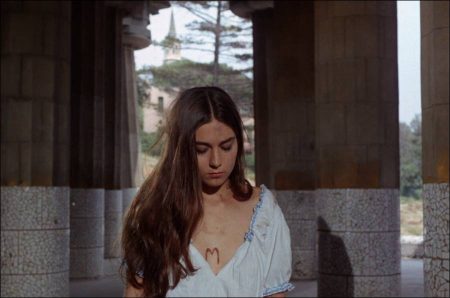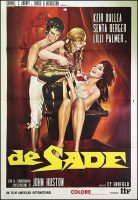De Sade movie storyline. Hounded by the police on charges of inflammatory writing, the once handsome Marquis De Sade seeks refuge in an abandoned family mansion. This colorful movie depicts DeSade’s life from childhood to manhood. A life infamous for erotic behavior, going from woman to woman, seeking a love that eludes him.
The film begins with a screen of text explaining that de Sade was born in about 1740 and spent 20 years or so of his life either in prison or in an insane asylum. Recurrently throughout the film there are various incidents in which a party of officers from either the police or the army attempt to arrest de Sade. De Sade usually evades capture until near the end of the film when he is caught in bed with a woman (i.e. no horse to hand to escape on/with).
The film has an episodic and (mostly) non-chronological structure. It portrays incidents from de Sade’s childhood, adulthood, marriage, imprisonment, institutionalisation in an asylum, old age, and finally death. The episodes are alternatively filmed as dreams, reminiscences from multiple points of view, theatrical performances, hallucinations, and as actuality.
Excerpts from de Sade’s biography (some of which are controversial) include experiences/accusations of child sexual & physical molestation at the hands of the Catholic clergy, de Sade’s criminal history in regards to accusations of physical abuse against him by a prostitute, de Sade’s arranged marriage, de Sade’s literary output in regard to plays, (obscene) stories, novels, de Sade’s imprisonment for obscenity, assorted sex orgies, and his eventual committal to Charenton asylum for the insane (some years after the French revolution).
De Sade (German title: Das Ausschweifende Leben des Marquis De Sade) is a 1969 American-German drama film directed by Cy Endfield and starring Keir Dullea, Senta Berger and Lilli Palmer. It is based on the life of Donatien Alphonse François, Marquis de Sade, named Louis Alphonse Donatien in the film.
Dullea, in his first film role since the 1968 release of 2001: A Space Odyssey, plays the title character in a film characterized by its psychedelic imagery and go-go sensibilities. As the dying Marquis recalls his life out of sequence, he is terrorized by his uncle and haunted by his own past of debauchery. It was shot at the Spandau Studios in Berlin and the Bavaria Studios in Munich. The film’s sets were designed by the art director Hans Jürgen Kiebach.
About the Story
The middle-aged Marquis de Sade arrives at his ancestral estate of La Coste, having escaped incarceration. In the theater at the castle, he meets his uncle, the Abbe, who persuades him to stay to watch an entertainment that has been prepared for him. The play is a parody of the Marquis’ parents haggling with M. and Mme. Montreuil over the prospective marriage of their children, leading to a flashback in time to the actual negotiations.
The young Louis flees the proposed marriage to Mlle. Renée de Montreuil, but returns and marries her under threat of imprisonment. Louis would prefer Renée’s younger sister Anne, finding Renée to be very frightened and cold to his charms. At an orgy with several young prostitutes, Louis begins to get very rough in his play and explains some of his philosophy to the women, leading to the first in a long series of imprisonments.
Released into the custody of his mother-in-law Mme. de Montreuil, Louis finds himself a prisoner in his own home. When Anne is sent away to a convent school, Louis begins liaisons first with his mother-in-law’s protégé, Mlle. Collette, and then with an actress, La Beauvoisin, for whom he builds a theater at La Coste. The first play performed is for the benefit of the Abbe, who is chagrined to see that the performance is about his own misuse of the young boy Louis. In a flashback, the actual event is played out, the Marquis’s later deeds and philosophy thus being given a cold-Freudian origin.
Louis proceeds through a series of flashbacks involving his father’s death, a mysterious and recurring old man, and the baptism day of one of Louis’ own children, culminating in the scandal of Rose Keller, a widow whom he ties up and flagellates with a sword. Mme. de Montreuil is forced to pay Rose for her silence, and to send Louis back into exile at La Coste.
Louis continues to pursue Anne, and after an elaborate orgy where he is whipped into unconsciousness, he flees to Italy with the young woman. Returned to prison, Louis is tormented with visions of Mme. de Montreuil disowning Anne and his uncle the Abbe seducing her. Mme. de Montreuil visits him in prison, and tearfully tells him he has ruined her family and that he will remain imprisoned forever.
De Sade (1969)
Directed by: Cy Endfield, Roger Corman, Gordon Hessler
Starring: Keir Dullea, Senta Berger, Lilli Palmer, Anna Massey, Sonja Ziemann, Christiane Krüger, Uta Levka, Barbara Stanek, Susanne von Almassy, Friedrich Schoenfelder, Herbert Weissbach
Screenplay by: Richard Matheson
Production Design by: Salvatore Billitteri
Cinematography by: Richard Angst
Film Editing by: Hermann Haller
Costume Design by: Evangeline Harrison
Art Direction by: Hans Jürgen Kiebach
Makeup Department: Fredy Arnold
Music by: Billy Strange
MPAA Rating: None.
Distributed by: American International Pictures (Uhiker Bkakeb), Columbia Film-Verleih (West Germany)
Release Date: September 25, 1969 (New York), August 1970 (West Germany)
Views: 1155


